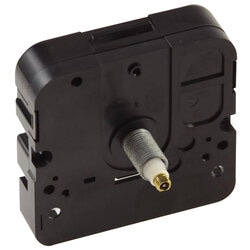Comprehending Clock Movements Operations

A clock movement is that makes the wrist watch job, or feature. The clock electric motor (likewise referred to as a movement in trade jargon) keeps track of how many pulses are being given off by a quartz crystal, thereby calculating where the hands require to be placed. The essential operation of this device is therefore conceptually easy, yet the feature set built on it can be potentially considerable and also even exotic.
In olden days a clock electric motor was strictly mechanical. A tightly curled spring or a dangling weight furnished enough rotational torque to turn a flywheel, and numerous sort of regulatory authorities controlled its rate. Pendulums, escapements, and also gear networks made sure precision of hand placement against a calibrated dial.
In today’s globe, the mechanical way of running clocks has actually passed the wayside, supplanted by digital techniques. Placing a voltage differential across a quartz crystal triggers it to produce pulses at a high and also plain frequency, as well as building up the pulse matter causes a record of elapsed time. Digital registers shop the matters, as well as software converts the instantaneous record into hours, minutes, and also seconds.
This, then, is how the contemporary temporal movement works, at least on a basic level, obviating the demand for (reasonably) large flywheels, pendulums, and networks of equipments. But lack of mass likewise permits much advancement, in regards to performance as well as increased function collections, because software program execution is relatively quick. Timekeeping can be extended in numerous ways, and uniqueness functions are simple to include.
Prolonged timekeeping can be found in the kind of longer-than-normal cycles prior to every little thing resets. As an example, we are used to seeing clocks that reset every twelve hrs (no distinction between AM and PM), yet there are motors that reset every 24 hr, or each week, or on a monthly basis. Such extensions generally require an alike adjusted dial, as well as often an extra hand is required to reveal the day of the week or the day of the month.
An additional timekeeping difference is the visibility or lack of a second hand; some favor the constant ticking, while others like no interruption. However, it is feasible to have a clock electric motor that supports a pre-owned that is silent and continually sweeping across the dial. So, the alternatives are for a second hand that (a) ticks and jerks every second, (b) constantly as well as silently sweeps, or (c) is missing completely.
A special type of time expansion relates to showing tidal details; the trends are cyclical, but acquired mainly from the lunar cycle equating to 24 hours as well as 50 minutes. Therefore, it is straightforward to set a wrist watch electric motor to reset itself according to the lunar timetable, with high tides as well as low tides showed properly. Of course, the electric motor needs to be initialized appropriately, taking local conditions right into consideration.
Non-cyclical weather sensations can also be displayed making use of a clock movement, though periodicity of procedure is replaced with real-time conversion of input from sensing units. Below, the dial is really direct, not round, as well as a single hand ranges in between the two extremes according to the value signed up on the sensing unit. It is common to locate motors that present temperature, moisture, and/or barometric pressure in this way.
Novelty attributes are additionally conveniently set into clock movements. Playing chimes in one of the usual tunes (e.g., Westminster) is easily available, with or without an hour matter complying with. Pendulums, no more important mechanical parts for watch operation, however give rate of interest as cosmetic oscillations.
Simply put, the old-style clocks (mantle, cuckoo, grandfather, and so on) are easily reproduced today electronically, tweaking fundamental movement operations and also executing extra complex performance in software application. There is virtually nothing that can not be completed through correct understanding of clock mechanisms functions.
